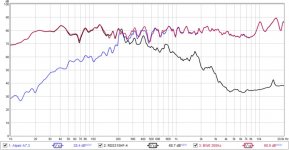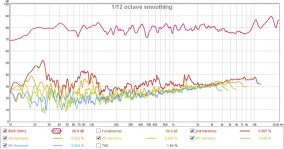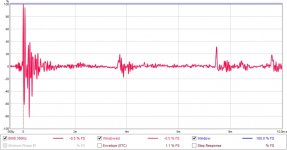We are all big boys and understand the applicability of a measurement to a particular room. That should not stop us from sharing what our measurement looks like in *our* room....
More data is always better than no data.
I think you're absolutely right and I certainly agree with you.
I didn't intend to completely dismiss the usefulness of sharing measurements, just as long as the knowledge of room effects are known to those interpreting the information the data is certainly very useful. But this is DIY, so it should be a "no duh..."
OK. I'll play. The room is 25'x13'x8'. One long wall, with the speakers centered, and the floor are cast concrete. The left short wall, the back wall and the ceiling are drywall. The right short wall is glass with a heavy cotton curtain over the windows. The left rear corner is open into a 6'x10' landing for a stair will. The floor is covered with carpeting and there is a fair amount of soft furniture scattered about. The speakers are 3' from the wall, 7.5' apart and the chair 7.5' from the speakers. The bass speakers are Dayton RSS315HF-4's in 2ft^3 sealed boxes that are 24" tall. the treble speakers are Alpair 7.3's in folded TL's sitting on top of the bass speakers. The microphone is centered on my head and 2" above my head.
Have fun.
Bob
Have fun.
Bob
Attachments
Don't want to get in the middle of a running gun battle! But!!
 It always amazes me that someone has to have a graph or a chart to take a man at his word about a given subject. Now if one of the speaker designers on this site, with as many years in sum, tells me his/her design will give me x-number Hz-KHz give or take a little either way given room acoustics, then I'm inclined to take them at their word. I'll let my ears be the judge or ask about a way to tune it to my my way of listening. All of the long term speaker designers on here have given selflessly to all who ask!! If you want to have measurements, then build the speaker, get out the mic and the appropriate sound measurement program, and measure until your heart is content. Me, I'm inclined to be thankful of those years of wisdom and dedication, and if they tell me that if you measured the same speaker in ten thousand different rooms that no two results would be the same, then again I believe they might be on to something!!
It always amazes me that someone has to have a graph or a chart to take a man at his word about a given subject. Now if one of the speaker designers on this site, with as many years in sum, tells me his/her design will give me x-number Hz-KHz give or take a little either way given room acoustics, then I'm inclined to take them at their word. I'll let my ears be the judge or ask about a way to tune it to my my way of listening. All of the long term speaker designers on here have given selflessly to all who ask!! If you want to have measurements, then build the speaker, get out the mic and the appropriate sound measurement program, and measure until your heart is content. Me, I'm inclined to be thankful of those years of wisdom and dedication, and if they tell me that if you measured the same speaker in ten thousand different rooms that no two results would be the same, then again I believe they might be on to something!!
Just my two cents worth, and we all know the story about opinions!!!
Thanks, Mac
 It always amazes me that someone has to have a graph or a chart to take a man at his word about a given subject. Now if one of the speaker designers on this site, with as many years in sum, tells me his/her design will give me x-number Hz-KHz give or take a little either way given room acoustics, then I'm inclined to take them at their word. I'll let my ears be the judge or ask about a way to tune it to my my way of listening. All of the long term speaker designers on here have given selflessly to all who ask!! If you want to have measurements, then build the speaker, get out the mic and the appropriate sound measurement program, and measure until your heart is content. Me, I'm inclined to be thankful of those years of wisdom and dedication, and if they tell me that if you measured the same speaker in ten thousand different rooms that no two results would be the same, then again I believe they might be on to something!!
It always amazes me that someone has to have a graph or a chart to take a man at his word about a given subject. Now if one of the speaker designers on this site, with as many years in sum, tells me his/her design will give me x-number Hz-KHz give or take a little either way given room acoustics, then I'm inclined to take them at their word. I'll let my ears be the judge or ask about a way to tune it to my my way of listening. All of the long term speaker designers on here have given selflessly to all who ask!! If you want to have measurements, then build the speaker, get out the mic and the appropriate sound measurement program, and measure until your heart is content. Me, I'm inclined to be thankful of those years of wisdom and dedication, and if they tell me that if you measured the same speaker in ten thousand different rooms that no two results would be the same, then again I believe they might be on to something!!Just my two cents worth, and we all know the story about opinions!!!
Thanks, Mac
It always amazes me that someone has to have a graph or a chart to take a man at his word about a given subject. Now if one of the speaker designers on this site, with as many years in sum, tells me his/her design will give me x-number Hz-KHz give or take a little either way given room acoustics, then I'm inclined to take them at their word. I'll let my ears be the judge or ask about a way to tune it to my my way of listening. All of the long term speaker designers on here have given selflessly to all who ask!! If you want to have measurements, then build the speaker, get out the mic and the appropriate sound measurement program, and measure until your heart is content. Me, I'm inclined to be thankful of those years of wisdom and dedication, and if they tell me that if you measured the same speaker in ten thousand different rooms that no two results would be the same, then again I believe they might be on to something!!
Just my two cents worth, and we all know the story about opinions!!!
Thanks, Mac
It's not an issue of trust or whether or not I believe someone's sim. I design and model speakers too (check out all my builds in the FC thread and other threads), and I also make measurements and even provide sound clips if anyone is interested. Measurements don't always agree with sims, and some speakers cannot be sim'd properly unless you go with a 3d finite element approach. Again, it's not just the room effects (below 200Hz), we are interested in intrinsic speaker response above that which is independent of the room.
hope you're not referring to me on the "man at his word" thing (?) - just complimenting Bob on a pretty set of data (had a cat feeding break) - which man? which speakers? which claims? - it does not hurt to have data although I've published some pretty embarrassing stuff ;^)
Last edited:
OK. I'll play. The room is 25'x13'x8'. One long wall, with the speakers centered, and the floor are cast concrete. The left short wall, the back wall and the ceiling are drywall. The right short wall is glass with a heavy cotton curtain over the windows. The left rear corner is open into a 6'x10' landing for a stair will. The floor is covered with carpeting and there is a fair amount of soft furniture scattered about. The speakers are 3' from the wall, 7.5' apart and the chair 7.5' from the speakers. The bass speakers are Dayton RSS315HF-4's in 2ft^3 sealed boxes that are 24" tall. the treble speakers are Alpair 7.3's in folded TL's sitting on top of the bass speakers. The microphone is centered on my head and 2" above my head.
Have fun.
Bob
Thanks for playing along. You have nice measurements frequency wise and HD wise. But the one thing you have is a lot of acoustic 'after taste' due to the impulse response ringing - corresponding to the two cone breakup peaks above 10kHz that the A7.3 is known for. I think percussive sounds will have a shimmer and voices will have a sibillant quality. As I recall, this driver behaves better 15 deg off axis where these peaks go down. However, this acoustic aftertaste may actually be pleasing sounding to some - I believe this acoustic aftertaste makes soft impulses more audible. What this means is that it gives an apparent enhanced audibility of soft sharp sounds that otherwise is not there in the original recording. Some folks may call this "enhanced detail", or it might be the same as DDR to some? This seems to be more common in aluminum diaphragms.
If we look at the comparison between the A7.3 and the TC9FD's impulse response as previously seen here:
http://www.diyaudio.com/forums/full-range/267966-why-bother-frs-5.html#post4184730
Here is the A7.3 IR from pnix's measurements, it looks very similar to your IR:
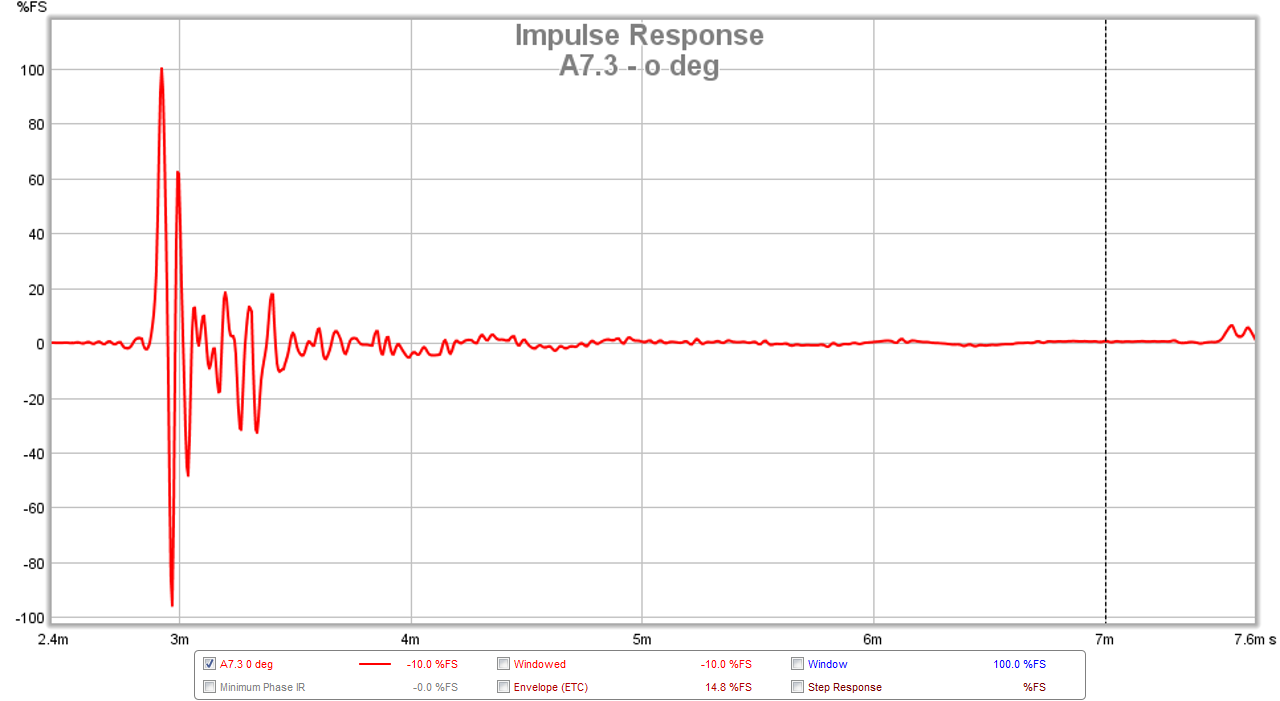
Here is the IR from your measurement:
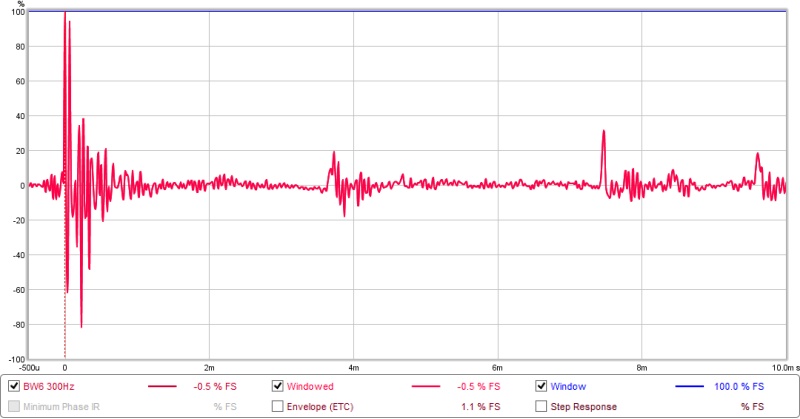
Here is the TC9FD's IR:
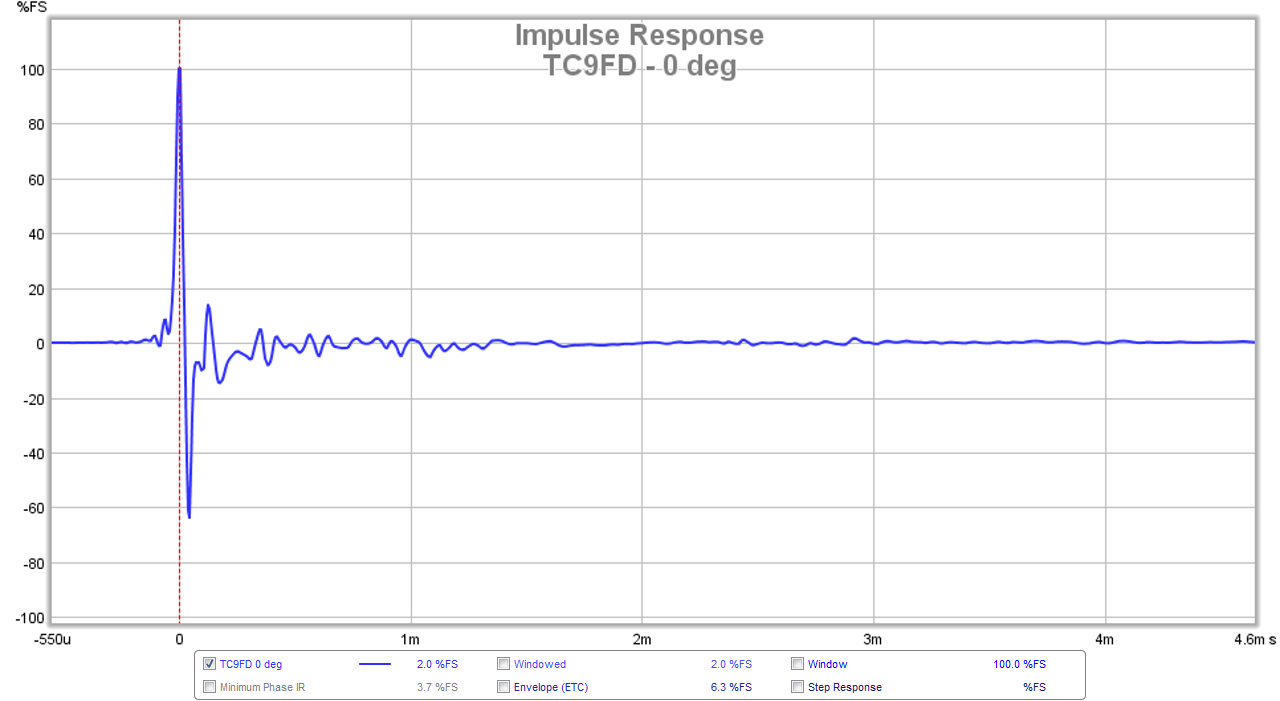
Now listen to what an impulse response sounds like from each driver, which one persists longer and is more audible?
A7.3 IR wav file:
http://www.diyaudio.com/forums/attachments/full-range/459100d1421174504-why-bother-frs-a7.3-sound-impulse-0-15-30-deg.zip
TC9FD IR wav file:
http://www.diyaudio.com/forums/attachments/full-range/459101d1421174504-why-bother-frs-tc9fd-sound-impuls-0-15-30-deg.zip
Last edited:
My remarks were concerning this entire thread, and not one individual, or one post. I have read virtually every forum in this site, as I'm a disabled military retiree and veteran, with an over abundance of time on my hands. I have seen virtually every design, by a countless number of contributors, courtesy of their time and hard earned money, who have given those with less means a way to have an audio system to write home about. That was where my heart was when I posted. So, now maybe you can see where I was coming from.
Thanks for all you guys do to make this forum something special!!
Mac
Thanks for all you guys do to make this forum something special!!
Mac
My remarks were concerning this entire thread, and not one individual, or one post. I have read virtually every forum in this site, as I'm a disabled military retiree and veteran, with an over abundance of time on my hands. I have seen virtually every design, by a countless number of contributors, courtesy of their time and hard earned money, who have given those with less means a way to have an audio system to write home about. That was where my heart was when I posted. So, now maybe you can see where I was coming from.
Thanks for all you guys do to make this forum something special!!
Mac
Ironhands,
We here in the US all owe you our most sincere respect and gratitude for the service you have given to the nation. Glad you can join us in this forum and in this hobby - welcome aboard! If you have lots of time, get some FC boards, a hot melt glue gun and xacto, a mic and REW software and you are set to go.
Regards,
X
Here is an example of someone in the Wibaq thread who just posted his build along with a measurement in his room along with commentary. I think it was helpful to have data.
http://www.diyaudio.com/forums/full-range/226767-wibaq-tabaq-design-betsy-k-12.html#post4217549
http://www.diyaudio.com/forums/full-range/226767-wibaq-tabaq-design-betsy-k-12.html#post4217549
Freddi and XRK, thanks to you both for your contributions to others on this site with your speaker designs and your findings in all the experiments you have done.
I have been using this site for many years from time to time, but only recently contributed/joined. Thanks for the welcome, as well!!
I will doing many builds in the future to give to my children/grandchildren as something special from me to them.
As for my military service, that was payment to this country, so that maybe we could all live in peace once and for all, and my children and grandchildren would'nt have to make that choice!
You guys keep on keeping on so we all have some speakers to build, and listen to!!
Thanks, Mac
I have been using this site for many years from time to time, but only recently contributed/joined. Thanks for the welcome, as well!!
I will doing many builds in the future to give to my children/grandchildren as something special from me to them.
As for my military service, that was payment to this country, so that maybe we could all live in peace once and for all, and my children and grandchildren would'nt have to make that choice!
You guys keep on keeping on so we all have some speakers to build, and listen to!!
Thanks, Mac
Count me in belonging to the group that finds it useful to take measurements to figure out what's happening in the room. But the path I have chosen with full range arrays asks for that anyway. They need EQ to be able to be listenable. (though they don't sound bad at all without any EQ at all as backup/fill in complementing my TV speakers  )
)
I basically tune the speakers within the room as a whole. It is a learning experience for me and so far it pays off. As my graph's continue to look better the sound isn't getting any worse from what I've heard so far.
Measurements can be found here: measurements for my particular project using both EQ and DRC-fir.
I basically tune the speakers within the room as a whole. It is a learning experience for me and so far it pays off. As my graph's continue to look better the sound isn't getting any worse from what I've heard so far.
Measurements can be found here: measurements for my particular project using both EQ and DRC-fir.
+1 exactly the thing we need. The paucity of data is just puzzling to me.
Measuring, data interpretation, relating measurements to perception is tedious, boring, complicated and a potential threat to personal beliefs. That's why most people don't like 'data'.
Then there's people with commercial interests and 'data' is the worst thing that could happen. It might enable people to compare your product in an objective way to other products. Bad!
Last edited:
Easy to provide reults that are more ghost than useful.
When the only tool you have is a hammer, everything starts looking like a nail.
dave
So you suggest to do away with the hammer?
The hammer is a useful tool, but not for cutting anything or for driveing a screw.
dave
True but you don't seem to accept the hammer as a valid tool instead you seem to fight the whole category.
Has anyone ever posted measurements of his or her hearing? I had temporary hearing loss in one ear a few years ago. (Still not sure why, though it was coincident with a bad cold, so presumably sinus related.) One of the tests they did resulted in a graph similar to the frequency response graphs I've seen for speakers. Basically, in a soundproof room, they fitted me with one headphone, and a trigger button. Then they played random tones into the headphone, varying the pitch and loudness. Every time I heard something I hit the button. Repeat for the other ear. It took a while, as you might guess. And in the interest of time, the frequencies tested moved around in large jumps.
Dammed if all that wasn't well before my interest in diyaudio, and what I've learned since. So at the time, I was primarily concerned with actually being able to hear out of both ears. If I were to need that today, I would ask for a copy, as I'm sure folks here might find it interesting. And even today I wish I could remember the details.
As such, I don't remember exactly what the graph looked like for each ear, but they certainly weren't perfectly flat. I've often thought that each person probably has a unique graph, like a fingerprint. That alone might explain why two different people perceive a speaker's subjective quality differently, regardless of measurements.
Dammed if all that wasn't well before my interest in diyaudio, and what I've learned since. So at the time, I was primarily concerned with actually being able to hear out of both ears. If I were to need that today, I would ask for a copy, as I'm sure folks here might find it interesting. And even today I wish I could remember the details.
As such, I don't remember exactly what the graph looked like for each ear, but they certainly weren't perfectly flat. I've often thought that each person probably has a unique graph, like a fingerprint. That alone might explain why two different people perceive a speaker's subjective quality differently, regardless of measurements.
I have undergone the same measurements and it made one of my listening impressions very clear.
My ears left and right are a very close match. I had a slight dip at 1 kHz, but it was the same for both ears. At 6 kHz my hearing is as sensitive as the usual peak in our hearing system at ~3-4 kHz, explaining to me my personal sensitivity to sibilance in speakers.
My ears left and right are a very close match. I had a slight dip at 1 kHz, but it was the same for both ears. At 6 kHz my hearing is as sensitive as the usual peak in our hearing system at ~3-4 kHz, explaining to me my personal sensitivity to sibilance in speakers.
True but you don't seem to accept the hammer as a valid tool instead you seem to fight the whole category.
I did not say that, It is a useful tool. Just not sufficient by itself. I think i have made that pretty clear.
dave
- Status
- This old topic is closed. If you want to reopen this topic, contact a moderator using the "Report Post" button.
- Home
- Loudspeakers
- Full Range
- Usefulness of In-Room LF Measurements vs. No Measurements (ref FH)
